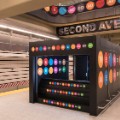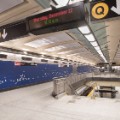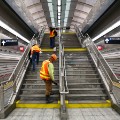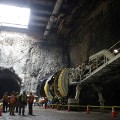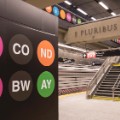(CNN)Here's some background information about the Metropolitan Transportation Authority (MTA), which serves 15.3 million people across New York City, Long Island, southeastern New York state and Connecticut.
Facts
The MTA is the largest public transportation network in North America.
It is run by the state of New York, not the city government.
MTA is partnered with Operation Lifesaver, a national rail safety organization.
The system is patrolled by the MTA Police Department and the New York Police Department's Transit Bureau.
MTA has produced nine "generations" of the "If You See Something, Say Something" campaign, which encourages customers to notify the police and MTA employees of suspicious activity.
The MTA network includes these agencies: MTA New York City Transit, MTA Bus Company, MTA Long Island Rail Road, MTA Metro-North Railroad, MTA Bridges and Tunnels (B&T) and MTA Capital Construction.
Statistics (source: MTA)
The MTA employs more than 75,000 people.
The operating budget for 2022 is $18.5 billion.
Ridership reached 1 billion for the first time since the pandemic in 2022; with a 3.2 million daily ridership.
There are 472 subway stations.
Track and bus routes over 5,000 square miles.
5,927 buses in the bus fleet.
6,684 subway cars rode 665 track miles in 2019.
The Times Square-42nd Street station was the busiest subway station in 2022.
Timeline
October 27, 1904 - The first official subway system, the Interborough Rapid Transit Company or IRT, opens in Manhattan. The 9.1-mile long subway line consists of 28 stations from City Hall to 145th Street and Broadway.
1905 - Subway service expands to the Bronx.
1907 - Bus service begins in Manhattan.
1908 - Subway service expands to Brooklyn.
1915 - Service expands to Queens.
July 25, 1953 - Tokens are first used in the subway.
March 1, 1968 - The New York state legislature establishes the MTA to manage and operate transportation in 12 counties.
1973 - Long Island bus service opens.
July 4, 1997 - Metrocard debuts as a form of payment.
August 23, 2005 - Lockheed Martin is selected as the prime contractor for the program initiating a comprehensive upgrade of MTA's electronic security operations infrastructure.
October 6, 2005 - Mayor Michael Bloomberg announces the FBI has shared with New York officials a "specific threat" against the city's subway system.
October 7, 2005 - An apparent hoax involving a soda bottle filled with a "Drano-like substance" prompts the temporary closure of parts of Pennsylvania Station at the height of morning rush hour.
October 11, 2005 - Government sources tell CNN that the information from an informant in Iraq that sparked heightened security in and around the New York City Transit system on October 6 was a hoax.
December 16, 2005 - New York's subway and bus workers, a union of more than 33,000 personnel, call for a partial strike against private bus lines. The drivers will complete their morning rush-hour routes and return the buses to the depots before going on strike.
December 20, 2005 - A full strike of the union transit workers goes into effect at midnight.
December 22, 2005 - The Transit Workers' Union, Local 100, votes to send transit employees back to work while talks with the MTA continue.
June 24, 2009 - London-based bank Barclays purchases the Atlantic Avenue/Pacific Street transit hub in Brooklyn for $4 million.
August 27, 2011 - MTA in New York shuts down, joining Philadelphia and New Jersey in suspending service in advance of Hurricane Irene, New York Gov. Andrew Cuomo's office says.
August 29, 2011 - MTA suspends service on the Port Jervis Line indefinitely due to damage sustained during Hurricane Irene. The MTA press release states that the damage includes:
- Three washout locations of 1,000 feet each near Sloatsburg
- A 400-foot section of track washed out to a depth of eight feet south of Sloatsburg
- Significant damage to several railroad bridges
- Significant damage to the signal system, which is exposed and under water
- Three washout locations of 1,000 feet each near Sloatsburg
- A 400-foot section of track washed out to a depth of eight feet south of Sloatsburg
- Significant damage to several railroad bridges
- Significant damage to the signal system, which is exposed and under water
August 27, 2012 - MTA submits insurance claims to the Federal Emergency Management Agency (FEMA) to recoup the losses suffered during Hurricane Irene in 2011. The losses total $65 million.
October 2012 - Superstorm Sandy causes flooding in subway tunnels. Damages to the Rockaway Line are expected to take months to repair.
November 26, 2012 - Governor Cuomo announces it will cost $5 billion to repair the MTA after Superstorm Sandy.
February 1, 2013 - Celebration of the 100th anniversary of Grand Central Terminal begins.
May 24, 2016 - Governor Cuomo announces final approval of a $27 billion, 5-year MTA spending plan designed to renovate and expand the MTA network.
June 29, 2017 - Cuomo declares a state of emergency at the MTA, in response to faltering service and infrastructure problems. As part of the disaster declaration, Cuomo commits $1 billion to the MTA capital plan and gives MTA leaders 30 days to come up with a game plan.
July 25, 2017 - MTA Chairman Joseph Lhota unveils the Subway Action Plan to help improve the troubled transit system.
July 24, 2019 - The MTA votes to accept recommendations made in its capital plan report, which was released July 17, 2019. The report, based on evaluations conducted by AlixPartners, includes calls for cost saving measures that could result in job cuts. This is the first reorganization in the MTA's 51-year history.
May 6, 2020 - For the first time in its 115-year history, New York City deliberately shuts down its entire subway system. The subway has previously been shut down because of weather, but this is the first planned shutdown. The MTA will be cleaning on a nightly basis to prevent the spread of the coronavirus.








